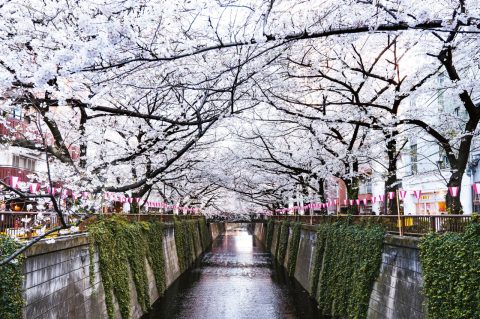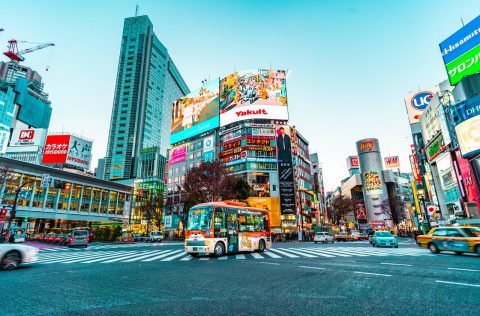15 of the Best Things to do in Japan
Where should you start when planning a trip to Japan? Whizzing past Mount Fuji on a shinkansen train may be at the top of the bucket list, alongside soaking in a steamy hot spring, taking a deep dive into onsen culture or visiting a fairytale theme park. But there are also immersive hikes, incredible food and transformative traditional experiences such as tea ceremonies or sumo matches to consider. Start here with our list of the best things to do in Japan and build your ideal itinerary, whether it’s your first or 15th time in this magical country.
Soak (and see the sights) in an onsen town
1/16Kinosaki Onsen, just a few hours by train from Osaka, is one of Japan’s most picturesque and historic hot-spring towns. Famous for its seven tattoo-friendly public bathhouses (many onsen do not allow entry to those with ink), the town's charming canal-lined streets brim with visitors wearing cotton yukata robes, trying different onsen and snacking on rice crackers made with carbonated spring water. It’s a beautiful blend of tradition and relaxation, ideal for both first-timers and seasoned onsen lovers alike.
Belt out a tune at karaoke
2/16In Japan, karaoke is more than just a pastime – it’s a cultural phenomenon. People go to karaoke to celebrate, to cap off a night out or simply to relieve stress after a day at the office. In Tokyo, you can channel your inner movie star at the iconic Karaoke Kan in Shibuya, the setting of the famous singing scene in Lost in Translation. (For the full movie experience, book room 601 or 602, where the crew filmed.) Want to pair karaoke with sightseeing? Try singing your heart out on a ferris wheel in Tokyo Dome City, where all gondolas have a karaoke machine – just choose your songs carefully, as a full revolution takes only 15 minutes or about four songs’ worth of time.
Image credit: A Certain Aesthetic - stock.adob
Experience a traditional tea ceremony
3/16Enjoy a peaceful pause in your travels to admire the quiet beauty of Japanese culture with a traditional tea ceremony. Learn the rituals of matcha preparation from expert hosts, taste seasonal wagashi sweets and even dress in a kimono for the full experience. At Camellia Tea Ceremony in Kyoto, you can experience the art of tea with English instruction. The ceremony reflects centuries of aesthetic philosophy, emphasising grace, mindfulness and simplicity.
Image credit: Alamy Stock Photo
Eat your fill of authentic ramen
4/16For ramen lovers, the Shin-Yokohama Ramen Museum in Yokohama is a must-visit. Part museum and part retro theme park, it recreates a late 1950s Tokyo streetscape and serves up regional ramen from all over Japan. Wander the nostalgic alleys, opt for half-sized bowls so you can sample a variety of flavours, learn the dish’s history and take a ramen-making class. It’s a fun and delicious way to deepen your appreciation of one of the country’s favourite comfort foods.
Image credit: vichie81 - stock.adobe.com
Stay in a fairytale village
5/16Tucked deep in the Northern Alps, winter in the picturesque villages of Shirakawa-go in Gifu and Ainokura in neighbouring Toyama look like scenes from a snow globe. These traditional mountain hamlets are renowned for their gassho-zukuri farmhouses with steeply thatched roofs designed to withstand heavy snowfall. Many of the homes are more than 250 years old and some welcome guests for overnight stays; try Ainokura ryokans, where structures date back to the 17th century.
Image credit: N/ymzk - stock.adobe.com
See the sumo
6/16Japan’s national sport of sumo wrestling is steeped in ritual and drama. You can catch professional tournaments in Tokyo, Osaka, Nagoya and Fukuoka throughout the year – book tickets online, a few months in advance. For a close-up experience, visit a sumo stable to see the morning practice. At Arashiobeya in eastern Tokyo, you can watch for free from the street through large windows or from inside with an official tour. In Osaka, pair an exhibition match with a dinner of hearty sumo dishes at Ochiizumi, an eatery run by a former champion wrestler.
Image credit: Peter Adams - stock.adobe.com
Stroll through the seasons
7/16Along with Koraku-en in Okayama and Kairaku-en in Ibaraki, Kenroku-en in Kanazawa on the Sea of Japan coast is considered one of the country’s most beautiful landscaped gardens. This former feudal lord’s strolling garden was developed over generations since the 17th century, inspired by local literature and ancient legends. Skirt tranquil ponds and cross stone bridges to discover charming teahouses, as each winding path reveals a new perspective. It’s stunning no matter the season; there are cherry blossoms in spring, green bamboo thickets in summer, fiery maples in autumn and snowy landscapes in winter.
Take a walk
8/16The Kumano Kodo pilgrimage trails in Wakayama, a prefecture just south of Osaka, are over a thousand years old and wind through forested mountains and past sacred shrines. A designated UNESCO World Heritage site, the most accessible stretch is Daimon-zaka, a mossy stone staircase surrounded by ancient cedar trees. It leads to the stunning Kumano Nachi Taisha Grand Shrine as well as Japan’s tallest waterfall. Whether you try a short stroll or a multi-day trek, walking part or all of the Kumano Kodo is a picturesque way to experience Japan’s spiritual heartland.
Or, for a stroll-worthy route, Hitachi Seaside Park (about 1.5 hours by train from Tokyo, followed by a 20-minute shuttle) is a flat, 350-hectare site blanketed by flowers. From late April to mid-May, nemophila is in full, blue bloom and is a truly stunning sight to wander amongst.
Tour a majestic castle
9/16Himeji Castle, about a 45-minute train ride from Kyoto, is Japan’s best-preserved example of feudal-era architecture and has been designated a UNESCO World Heritage site. Nicknamed the “White Heron Castle” for its elegant, soaring design, it dates back to the early 1600s and features ingenious defensive design from maze-like approach paths to its abundance of wall openings used for firing arrows and dropping stones on intruders. Climb to the top of the main keep for sweeping views of Hyogo prefecture’s pillowy green mountains and explore the former daimyo’s (feudal lord) quarters.
Image credit: joyfuji - stock.adobe.com
Ride the shinkansen
10/16Reaching speeds above 300 kilometres per hour, Japan’s shinkansen trains are a convenient and quick way to get around the country in comfort. They’re also a great way to do some seated sightseeing: on a clear day, the elevated tracks offer a postcard view of Mount Fuji as you travel through Shizuoka (from Tokyo towards Osaka, sit on the right side of the train). For a short experience, ride north from Tokyo to Omiya (about 20 minutes), then explore the Railway Museum where you can step inside the first-ever shinkansen, inaugurated in 1964 for the Tokyo Olympic Games. If you plan to travel extensively by fast train, purchase a Japan Rail Pass (it offers the best value for multiple journeys).
Image credit: phurinee - stock.adobe.com
Shop at a traditional morning market
11/16Start your day like a local with a visit to one of Japan’s vibrant morning markets. Whether you're wandering through the bustling Tsukiji Outer Market in Tokyo to snack on wagyu steak bites and sushi or shopping for crafts at the riverside Miyagawa Morning Market in Takayama, historical markets are found in most cities across the country and offer a rich glimpse into daily life. Our tip? Prepare for an early start: many open at around 6am and are bustling even that early in the day.
Sleep like a monk
12/16For a peaceful and immersive cultural experience, consider spending some time at a Buddhist temple lodging or shukubo. As part of your stay, you can participate in morning chants, try Zazen meditation and enjoy shojin ryori, the simple, mostly vegetarian meals prepared by the temple’s monks. Daihonzan Eiheiji in Fukui is a working monastery established in 1244 that offers more comfortable accommodations for travellers, as well as a “Zen Concierge” to guide you through the temple experiences. (The town of Eiheiji is also famous for sake, so you can enjoy the other type of nourishment during a dinner out.)
Cycle across the sea
13/16The Shimanami Kaido is a spectacular 70-kilometre route that links Japan’s main island of Honshu to Shikoku, with bridges spanning a chain of scenic islands across the Seto Inland Sea. Designed with cyclists in mind, the route features dedicated bike paths and rental stations along the way, making it easy to ride as much or as little as you like. As you pedal past sea views and quiet fishing villages, make sure to stop and sample local seafood and fresh citrus fruits, then relax with a crisp beverage at the end of the day (the incredible waterside Wakka at the halfway point in Omishima does a mean coffee as well as craft beer). It’s an unforgettable journey through coastal Japan.
Image credit: Alamy Stock Photo
Do the theme park rounds
14/16Japan’s list of theme parks is long, offering visitors of all ages an unforgettable blend of magic, movies and art. Tokyo Disneyland and Tokyo DisneySea add a Japanese twist to the beloved American franchise, from Minnie in a kimono to Star Wars-themed mochi snacks. In Osaka, Universal Studios Japan delivers high-energy thrills as well as access to the colour-saturated adventure of Super Nintendo World. Ghibli Park in Nagoya offers a quieter, nature-filled escape, where scenes from Studio Ghibli films unfold across lush parklands. Meanwhile, Tokyo’s Ghibli Museum brings the studio’s whimsical universe to life via exclusive animations. For a futuristic twist, TeamLab Borderless and TeamLab Planets captivate visitors with mesmerising, interactive digital art.
Visit an island of art
15/16Naoshima, an island in the Seto Inland Sea, has been a bucket-list destination for visitors to Japan since it was transformed into a surreal haven for contemporary art back in 2014. Wander through Tadao Ando-designed museums, discover Yayoi Kusama’s iconic spotted pumpkins and explore quirky installations in unexpected places, from a whimsical public bathhouse to art-filled abandoned homes, easily explored by bicycle or local bus. In 2025, the Setouchi Triennale brings even more art to Naoshima and nearby islands like Teshima and Shodoshima from April through May. Stay at least one night to see it all; accommodations range from the exclusive Benesse House to more casual, cosy guesthouses.














